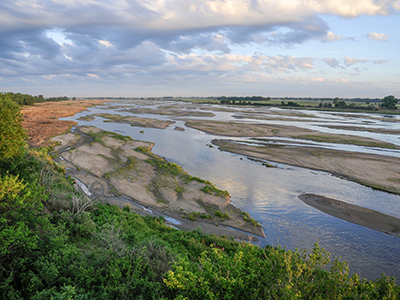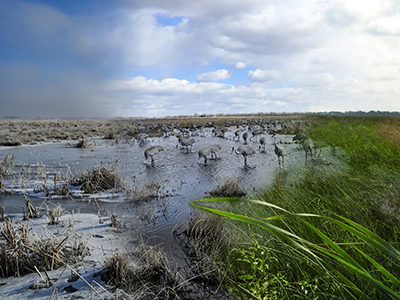DWFI continues support of Platte Basin Timelapse interns

Credit: Platte Basin Timelapse
Starting from its headwaters in Colorado, meandering through Wyoming and Nebraska, and finally spilling into the Missouri River, the Platte River is one of the most allocated rivers in the world, and much of its water is dedicated to agriculture.
The Platte Basin Timelapse project (PBT), founded in 2011 by photographers Michael Forsberg and Michael Farrell, is a program of the University of Nebraska–Lincoln (UNL) Institute of Agriculture and Natural Resources (IANR) which aims to bring the stories of this valuable resource – on which people, plants and animals depend – accessible to the public through multimedia content that blends art and research, STEM-based educational curriculum, university-level courses, and documentary films.
DWFI has supported PBT’s internship program since 2013, which recruits students from UNL and sets them up to pursue careers as science communicators, project managers, conservation storytellers, researchers, and scientists. This helps fulfill DWFI’s mission objective of sharing and enhancing knowledge; fostering future water and food security leaders; and developing effective techniques to sustainably manage water and increase food security through education and communication.
Not only is the internship program an excellent hands-on learning opportunity in communication and science, it is also essential to PBT’s work and mission. Student interns are trained in the use of technical, digital image-gathering and play an essential role in processing the PBT images into timelapse videos. They are also involved in the deep research for writing the rich, contextual background which is critical to impactful storytelling. The PBT team is also encouraged to suggest new ways to communicate to constituents through its website, newsletter, social media, presentations, graphics and animation. Since 2013, DWFI has helped fund 40 students, and all five of PBT’s full time staff are previous interns.

Credit: Platte Basin Timelapse
PBT has continually produced high quality and meaningful stories, which communicate the significance of Nebraska’s precious water resource. Two of PBT’s most recent projects, “High Plains Wild'' and “Counting Cranes,” were recently selected as official entries in various festivals. “High Plains Wild '' tells the story of the Bighorn Sheep in Nebraska’s Wildcat Hills. Once hunted to near extinction, they can now be found roaming the buttes of the North Platte River Valley thanks to conservation efforts to sustain their population. “Counting Cranes'' captures not only the incredible Sandhill Crane migration to the Platte River, but also the fascinating and skilled work it takes to document their numbers year after year.
Another project, “Witnessing a Watershed,” which was featured at the Kearney Walker Art Gallery, showcases multimedia selections from the more than 60 time lapse camera systems throughout the river’s 90,000 square-mile watershed. The exhibit featured photographs, videos and soundscape recordings from across the watershed and highlights the PBT’s impact on conservation, scientific research and experiential learning related to natural resources.
The communication of the ecosystems of people, plants and animals surrounding the Platte River Basin is crucial to fostering a deeper understanding of and connection to the resource, and DWFI is proud to contribute to a next generation of this research-based storytelling.
FY 2023 Annual Report
- Overview
- Introduction
-
Research and Policy
-
Global
- Brazilian agricultural state looks to Nebraska and DWFI to sustainably manage water resources
- Irrigation equipment ownership not always best for smallholder farmers
- McCornick and Neale re-elected to World Water Council, DWFI involved in preparations for the World Water Forum
- Understanding the agtech ecosystem in India can spur future investments
-
Regional + National
- DAWN Project testing its decision-support tools with corn and soybean growers
- Water Center director helps City of Lincoln find second water source
- Water, Climate and Health program makes an impact in Nebraska
- DWFI's flux tower network now helps validate carbon credits
- Understanding climate’s effect on the health of Americans
- Groundwater transfer success stories guide water managers in meeting local water needs
- Advancements in crop modeling help adapt to climate change
-
Global
-
Education
- Faculty Fellows
-
Supported Students
- DWFI funds eight new students working on mission-related projects
- DWFI continues support of Platte Basin Timelapse interns
- Estimation of manure nutrient capacity in Nebraska minimizes water quality impacts
- Could cover crops replace offset in-season corn fertilizer?
- Congratulations to DWFI-supported student graduates
-
Communication
- Digital and online engagement connects DWFI with its global audience
- Coverage of DWFI research and events reaches more than 219 million people
- Creative storytelling used to amplify DWFI smallholder irrigation research outputs
- DWFI expertise tapped for national reports and publications
- DWFI staff receive well-deserved recognition
- 2022 Nebraska Water Center Annual Report now available
-
Outreach and Events
- Global Conference draws international audience to address water and food security
- On-farm event in Western Nebraska strengthens partnerships, spurs new ideas
- Engagement recovers to pre-pandemic levels
- Drought at forefront of discussions at Platte River Basin Conference
- 49th Annual Water Tour broadens knowledge about Nebraska water
- Nebraska Water Center seminars focus on hot topics in Nebraska Water
- Development
- Resources
- Search
FY 2023 Annual Report
- Overview
- Introduction
-
Research and Policy
-
Global
- Brazilian agricultural state looks to Nebraska and DWFI to sustainably manage water resources
- Irrigation equipment ownership not always best for smallholder farmers
- McCornick and Neale re-elected to World Water Council, DWFI involved in preparations for the World Water Forum
- Understanding the agtech ecosystem in India can spur future investments
-
Regional + National
- DAWN Project testing its decision-support tools with corn and soybean growers
- Water Center director helps City of Lincoln find second water source
- Water, Climate and Health program makes an impact in Nebraska
- DWFI's flux tower network now helps validate carbon credits
- Understanding climate’s effect on the health of Americans
- Groundwater transfer success stories guide water managers in meeting local water needs
- Advancements in crop modeling help adapt to climate change
-
Global
-
Education
- Faculty Fellows
-
Supported Students
- DWFI funds eight new students working on mission-related projects
- DWFI continues support of Platte Basin Timelapse interns
- Estimation of manure nutrient capacity in Nebraska minimizes water quality impacts
- Could cover crops replace offset in-season corn fertilizer?
- Congratulations to DWFI-supported student graduates
-
Communication
- Digital and online engagement connects DWFI with its global audience
- Coverage of DWFI research and events reaches more than 219 million people
- Creative storytelling used to amplify DWFI smallholder irrigation research outputs
- DWFI expertise tapped for national reports and publications
- DWFI staff receive well-deserved recognition
- 2022 Nebraska Water Center Annual Report now available
-
Outreach and Events
- Global Conference draws international audience to address water and food security
- On-farm event in Western Nebraska strengthens partnerships, spurs new ideas
- Engagement recovers to pre-pandemic levels
- Drought at forefront of discussions at Platte River Basin Conference
- 49th Annual Water Tour broadens knowledge about Nebraska water
- Nebraska Water Center seminars focus on hot topics in Nebraska Water
- Development
- Resources
- Search
Top image caption
Located at Audubon’s Rowe Sanctuary, PBT’s camera atop of 35 foot tower provides a bird’s eye view of a braided river channel and shifting sandbars along the central Platte River.
Credit: Platte Basin Timelapse
Related Articles
Understanding the agtech ecosystem in India can spur future investments
By 2030, India will have a freshwater shortfall of about 50 percent. Agriculture accounts for 78 percent of the country’s water use and irrigation innovation will be key to meeting the demand for water and food in the future.
Irrigation equipment ownership not always best for smallholder farmers
Small farms less than 2 hectares — or about 5 acres — account for 11% of the world's agricultural land, yet they produce 35% of the world’s food.
DWFI's flux tower network now helps validate carbon credits
Demand is rising for carbon credits in fast-growing carbon markets.
COOKIE USAGE:
The University of Nebraska System uses cookies to give you the best online experience. By clicking "I Agree" and/or continuing to use this website without adjusting your browser settings, you accept the use of cookies.

